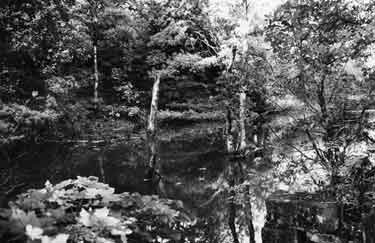
Introduction
The overgrown mill dam of the former Plonk Wheel is situated on the bank above the trail path. Nothing remains of the mill building or tail goit, but parts of the head goit can still be seen in places as a channel between the path and the hillslope above.
Built in 1737, the Plonk Wheel was used for cutlery grinding and possibly once as a saw mill. The Wheel had been abandoned by 1852.
History (c. 1737–1850s)
Also known as: Bobby Wheel, Sawbridge Mill (or Wheel), Siddall Wheel.
Main trades: Cutlery grinding, saw mill?

A photograph of Plonk Wheel mill dam in 1976 shows that it was much more open at that time. Sheffield City Council, Libraries Archives and Information: www.picturesheffield.com Image s36361.
Joseph Swallow & Thomas Bower built Plonk Wheel in 1737 and by 1759 it was running four trows. In 1794 the wheel pit is recorded as having a fall of 13 ft 4 in (c. 4 m), running five cutlers’ trows, with eight men employed but another two trows were in operation by 1814. In 1822 the tenant was Abraham Unwin, and there were two waterwheels.
By 1852 property lists show the owner of the ruined Siddall Wheel as Maria Kirby who, after a dispute with the Sheffield aterworks Company, accepted £550 for it in 1856. For some unknown reason the mill was never rebuilt or used again. One of the early names for the site tends to suggest that a saw-mill may have stood here.
Early 19 th Century maps show that the tail goit from Swallow Wheel fed water directly into the first of two small Plonk heel mill dams, these latter being linked by a culvert through the hillside. Some of the stones used in the 1960s for building the new path for the Nature Trail are said to have come from the Plonk weir, but it is not clear whether there was ever a weir here – there are some stone blocks set into the river by the north bank that could mark the remains, but a weir is not shown on old maps.
We are not aware of any old images of Plonk Wheel – please let us know if you come across any.
What's there now?
Having been abandoned over 150 years ago, and partly filled by slippage from the hillside above, the drained mill dam is in the final stages of silting up and is well wooded.
Nothing remains of the mill building or tail goit, but parts of the head goit can still be seen in places as a channel between the path and the hillslope above.
Nature and wildlife at Plonk Wheel
The former Plonk Wheel mill dam is situated on the bank above the trail path and is completely overgrown by trees and undergrowth. However, there is a wet area crossing the dam and the ground flora is quite diverse, including Bluebell, Celandine, Golden Saxifrage, horsetails, Stitchwort, Pink purslane, Violet and Wood Sorrel.
Location
It is easy to miss the site of Plonk Wheel, which is located on the north side of the river about 30–50 m upstream of the Hind Wheel weir. The site is owned by Sheffield City Council and there is open access. A public footpath passes the site.
A marker post installed at the site by Rivelin Valley Conservation Group gives a brief history and links
to this website.
OS map grid reference: SK 3075 8758
Nearest postcode: S6 5SD
